Industry-Sponsored Student Capstone Projects
2024/2025
In the 2024/25 academic year the industry capstone program was supported by 65 sponsors, more than half of which were returning, and 96 real-world projects. Over five hundred fifty students from across the College of Engineering participated. Scroll down to learn more about each project.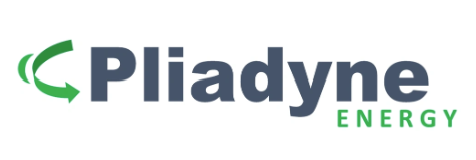
Pliadyne Energy
Slope-Based Gravity Energy Storage System
There are several major forces at play leading to the need for a significant increase in the amount of power generation, as well as energy storage capacity in the United States (and globally) in the coming decade. The combination of growing demand, decreasing base load and increasing intermittent load results in a huge increase in the need for more utility-scale energy storage - especially from sources that can provide long-duration storage (i.e., greater than 4 hours). The Capstone project described herein is in the category of Gravity Energy Storage (GES). This family of storage solutions has many of the same characteristics of Pumped Storage Hydropower, while at the same time overcoming the headwinds that seem to be preventing broad deployment of new PSH energy storage capacity – mainly because water is not used. However, these advantages are offset by engineering challenges regarding mechanical energy losses and lower energy density. A subset within the GES category is something called Slope-based Gravity Energy Storage (SGES). Challenges associated with GES are the result of having only one pool of mass moving between the two ends of the system. This results in a system with lower energy density and limited response time. An approach to address these challenges is called Decentralized Slope-based Gravity Energy Storage (DSGES). Like other gravity energy storage systems, DSGES systems consists of a motor/generator, driving device, slope, mass (discrete-unit or bulk), and mass transport mechanism. When DSGES generates electricity, the upper mass pool releases the mass to drive the generator motor to generate electricity. When DSGES is charged, the electric generator lifts the mass from the lower pool to the upper pool. The main difference lies in the use of decentralized mass pools (or stacks) located at different potential energy levels across the system. The decentralized stacks store a small amount of mass at different potential energy levels on the slope to quickly respond to changes in the system power requirements. Unlike conventional SGES, which only has upper and lower storage stacks, DSGES has some decentralized mass stacks also arranged on the slope, and each decentralized stack can independently mobilize mass. When DSGES runs in the power generation condition, when the power system needs DSGES to rapidly increase the power generation, the upper stack and the distributed stack begin to respond to the mass block or material mounted on the slope track at the same time, so as to achieve the rapid response to the power demand of the system. When the power system needs DSGES to quickly reduce the power generation, the excess mass/material block running on the slope cuts off the connection with the driving device and enters the lower distributed stack nearby to reduce the energy waste caused by the power response of the system. When DSGES runs in the charging condition, DSGES transports the mass block/material from the lower stack to the upper stack. The Capstone project involves the design and analysis of a 50 MW long duration DSGES at a specific site in eastern Washington. The deliverables envisioned for the project consist of two primary deliverables, and two secondary deliverables: Primary deliverables: (a) Feasibility Assessment. Though there have been a number of different MES systems proposed, developed and deployed in recent years, MES remains a non-mainstream approach to energy storage. Many challenges exist with the various MES approaches. These challenges include cost, mechanical losses, technical challenges, grid connection, controls, etc. As such, the nature of this project is somewhat speculative and aspirational. Therefore, a key project output is an assessment of the feasibility of the project. An objective and rational analysis of the viability of the project is sought. The feasibility assessment should be focused on financial and technical feasibility only. Other questions of feasibility - such as environmental, regulatory, marketability, financing, etc. – are outside the scope of the project. In addition, if the feasibility assessment concludes the project as defined is not feasible, or of questionable feasibility, feedback as to why it is not feasible is sought. (b) Cost-Performance model. It is envisioned that an interactive cost and system performance model will be created that allows the user to change variables and design parameters of the system (at the subsystem level) and see the resultant impact. Further, the model will also estimate the upfront capital cost to build the system, as well as estimate annual maintenance and operating expenses, and other major cost buckets. As the parameters of the design are changed in the model, the cost and system performance impact of these changes will be quantified. It is also envisioned that the model will include sensitivity analysis – meaning it will reflect how incremental changes to specific design variables impact the cost and system performance… revealing those variables that have the greatest impact on cost and performance, and those with less impact. Secondary Deliverables: (c) Benchmarks. Given the predominance of legacy PSH for utility-scale long duration storage today, a comparison of the system against PSH is to be done. Further, given the extensive use of Li-ion batteries in conjunction with new intermittent generation sources – such as solar – comparing the gravity energy storage system to Li-ion storage is also sought. The goal is to focus on key factors related to system performance, generation and storage capacity, development and construction lead time and critical cost factors. In addition, given that several new MES systems have been developed in the last 10-20 years, a comparison of key performance and cost parameters against these systems is also to be done. (d) Animation video. It is envisioned that a short, animated video will be created to help visualize the system in operation. As a minimum, this would show the system “charging” - pulling power off the grid and using it to move mass to the higher potential energy state. Also, it will show the system “discharging” - where mass is moved down the slope, generating electricity. Ideally, the animation will show “start-up” situation – where it transitions from idle to that of “charging”. Also, it will show “shut-down” – where the system transitions from “discharging” to idle. The main objective of the video is to help explain the system and how it works to non-technical constituents.

Scaniano
Scaniano – Brick/Sticker Scanner Piano
The student team will work to create/design/test a device/platform that allows a child to "build" a song that can be played. Build the song using LEGO blocks or equivalent pieces. Develop a method, device, platform that can 1) identify the pieces and their sequence 2) feed the notes into the platform and 3) play the notes on a special keyboard or equivalent when touched from left to right. Motivation: Introduce music and provide fun for anyone from ages 4 to 104 - no musical knowledge or skill required. The solution designed by the student team should be usable by preschool children to adult (4 to 104). Low cost. Simple way to lay out "notes" and play them. Prototype on IOS device or PC and re-implement on a Raspberry PI or Arduino. System recognizes the notes associated with the blocks and can play those notes when they are laid out left to right and a special keyboard is touched from left to right. The blocks do not need to be a part of the special keyboard, but the device system does need to be able to read the layout of the notes and change the keyboard behavior. The student team will work to deliver a prototype device that can play a musical melody of up to 100 notes by simply touching a special keyboard or equivalent. End product can be on any electronic device but should be as inexpensive as possible and usable by preschool children aged 4 (possibly with help).

Seattle Children's Hospital
Seattle Children's Search Optimization For Patients and Families
This student team will work to evaluate and optimize Seattle Children's mobile app and web page to allow patients and their families to easily and quickly search for relevant healthcare information in a clear and intuitive manner. The end product should prioritize equitable access, catering to a diverse audience with varying levels of digital literacy, making it easy for all users to find relevant content whether they are looking for general healthcare information regarding their stay, specific treatment details, or contact options for healthcare professionals. The primary motivation for this project is to improve the accessibility to digital content for our patients and families that come to Seattle Children's Hospital. As navigating through their healthcare journey can be stressful, Seattle Children's wants to empower their families and provide a "white glove" experience through their digital platforms that would allow them to quickly and reliably find information regarding their stay without facing unnecessary barriers. Seattle Children's hopes that by improving the accessibility to information they can enhance the patient experience and reduce information overload. This project would align with Seattle Children's department goals of improving patient experience and the likelihood to recommend. Project design parameters this student team will work to incorporate include: - Design a clean and intuitive mobile-first interface that allows for an intelligent way to search or retrieve digital content. - Provide the ability to filter or narrow search results, as well as the ability to search across different categories (locations, diagnoses, treatments). - Incorporate accessibility standards to ensure usability for individuals with disabilities. - Multilingual support. - Update Seattle Children's current Content Management app to support the features listed above. - Ensure the app is designed with security in the forefront, including HIPAA compliance, SSL encryption, and strong user authentication if needed. Performance criteria: -The design should allow for future expansion (new healthcare locations, services, languages, content). -The design should follow WCAG 2.1 accessibility guidelines and support localization. Project Scope: -Design and assist with search improvements for Seattle Children's current Mobile App (iOS and Android), leveraging Seattle Children's in-house developers and designers. -Design and assist with improvements to Seattle Children's Content Management App to support the new search features. -Designs will incorporate the ability to search, leveraging publicly available data sources such as Seattle Children's .org page and patient education database. -Designs will NOT incorporate direct integration with PHI (i.e., pulling clinical records into search). -Provide recommendations for improving search on Seattle Children's web page; however, the student team will work to focus on delivering the optimized search on mobile first. Design and work with Seattle Children's internal team to optimize search for the Seattle Children's Mobile App (iOS and Android). Design and work with Seattle Children's internal team to update the Content Management System for the Seattle Children's Mobile App, allowing for optimized search. Design and provide recommendations for seattlechildrens.org that can help support accessible and equitable search.

Shoonya Kids
Improving Early Literacy Outcomes for ELL Students Through Digital Storybooks
Students will work to develop a prototype for interactive multilingual storybooks to enhance foundational language skills for English Language Learners (ELL) ages 3-7 from diverse linguistic backgrounds. The scope this student team will work to incorporate includes: (1) Literature Review to understand developmentally appropriate storytelling techniques for early literacy, culturally responsive design, and how to create interactive digital tools appropriate for 3-7 year olds. (2) User Research with ELL students or Dual Language teachers, identifying the key elements of engaging storytelling in early literacy. (3) Ideation/Prototyping: Creating medium-fidelity digital prototypes that use multilingual stories and allow translanguaging. (4) User Testing/Refinement: Testing prototypes with target users and refining based on feedback. The final deliverable will be a digital multilingual storybook prototype. The storybook prototype this student team will work to create should meet the following design criteria: (1) Multilingual Support: The prototype must accommodate at least two languages (Hindi, Spanish, English). (2) User Engagement: Incorporate child-friendly interactive elements such as animations and touch-responsive elements that encourage exploration and reinforce letter-sound association. (3) Platform Compatibility: The prototype should be accessible via a web-based platform or iOS application. Additionally, this student team will work to incorporate Cultural Relevance: Embed themes and stories that resonate with diverse cultural backgrounds, especially those of ELL students. The student team will work to focus the performance criteria on user engagement from initial testing, relevance for teachers, and ease of use for young multilingual learners. The desired outcomes this student team will work to achieve include: (1) Medium-Fidelity Prototype: Interactive digital storybooks that align with Shoonya Kids’ standards for educational content (which will be provided). (2) User Research Insights: Insights on effective educational storytelling techniques for ELLs, which can guide future Shoonya Kids content development. (3) Usability Report: A report based on testing feedback that outlines the storybook’s strengths and areas for improvement. The final storybook prototype this student team will work to create should serve as a demonstration of how equitably designed multilingual stories can build confidence and bilingual literacy skills for ELL students.
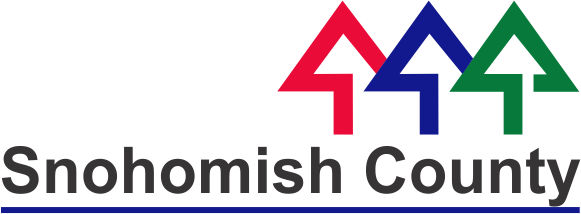
Snohomish County
Arlington Microgrid Solar Smoothing Pilot Project Analysis
The variability of photovoltaic (PV) generation from medium to large PV plants is a challenge for the balancing authorities like the Bonneville Power Administration (BPA) that are responsible for maintaining the balance between load and generation within their territory. Snohomish County PUD is currently conducting a pilot project with BPA to better understand how battery energy storage systems can be used to smooth the variations in solar output caused by changes in cloud cover. There are a number of different algorithms used and studies conducted to determine the quality/ success of the smoothing as well as the associated battery degradation. It would be beneficial to review the different methods and papers, talk to industry experts and create a computer model to help the utility industry better understand which methodology to use with the best compromise of grid benefits versus battery degradation. This project will use analysis and data from an actual project—a 500 kWac solar array paired with a 1MW/1MWh lithium-ion battery energy storage system at the Arlington Microgrid site in Arlington, WA. This project may involve the following: 1. Review existing methods, studies, and data. 2. Interview engineers from SnoPUD, BPA, Hitachi, etc. 3. Create a computer model to simulate the different solar smoothing and capacity firming methods. 4. Review actual data and compare to model. 5. Write a paper regarding the analysis, method comparison, and recommendations. The outcomes this student team will work to achieve are: -Create a computer model to simulate the various methods of solar smoothing, capacity firming, etc. -Write a paper regarding the analysis, method comparison and recommendations.

Snohomish County
Snohomish County Elections System
Snohomish County Auditor’s Office runs the elections system in the county. In 2024, the Elections team opened a new elections center that provides viewing areas for the public and significantly enhances the transparency of elections. Having just completed the Presidential elections, the county has significant lessons learned to make improvements to the elections flow. Students will work to examine the full lifecycle of elections management, starting from optimizing the locations of ballot boxes across the county, to the custody process of ballots from ballot boxes, to the elections center, and the end-to-end workflow of ballot management once the ballots arrive at the new elections center in county headquarters in Everett. Scope: From pickup of ballots to completed ballot counting. Parameters: 1) Optimal location of ballot boxes across county to provide equal access to ballot boxes. 2) Physical flow of ballots from the ballot box pickup point to the final validation of ballots. 3) Physical layout of the elections center to optimize end-to-end ballot flow. 4) Secure custody of ballots for the entire lifecycle of ballot management. Outcomes: 1) Ensure process provides secure custody of ballots from pickup to final validation 2) Optimally located ballot boxes across Snohomish County 3) Frequency and optimal routing of ballot pickup trips during elections 3) Optimal workflow of ballots within the Elections center in County HQ in Everett 4) Validation of technology solutions leveraged for end-to-end workflow management and control

Sony
Creating Intelligent Customer Facing Interactions
Students will work to identify ways Sony can improve their interactions with Sony customers. Sony seeks to enhance and improve the Sony customer experience. Sony wants to understand how the Sony customer wants to interact with the company when purchasing, troubleshooting, or asking questions. Sony wants to understand the customer’s ideal model of interactions and the customer's concerns with speaking to emerging technologies such as AI. Sony wants to be able to create personalized experiences that meet the Sony customer needs. Design Parameters and Performance this student team will work to incorporate include: - A focus on creating enhanced customer-facing interactions using AI - Consideration of the role of AI and similar models - A focus on creating consumer-facing tutorials or support using generative AI agents or support materials - A focus on purchases or post-purchase interactions (troubleshooting, question, customer service, etc.) - Application to any Sony product - Consideration of emerging technology and how it could be integrated to improve the purchasing experience Outcomes this student will work to achieve include: - Use cases or frameworks - A final report and presentation - Notes/recordings - Presentation at Sony to Sony stakeholders
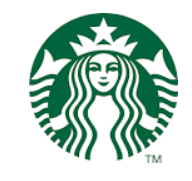
Starbucks
Quantifying and Reducing Ingredient Waste
Starbucks is committed to continuously improving its operational efficiency, focusing on both sustainability and cost management. One key area for improvement is the reduction of ingredient waste associated with the preparation of beverages and food items in stores. Waste from overuse, spillage, and customization errors not only increases operational costs but also has environmental and supply chain implications. The student team will work to develop a data-driven model that tracks and quantifies ingredient waste across stores. By analyzing patterns of overuse, spillage, and customization errors, the team aims to identify key contributors to waste and opportunities for improvement. Leveraging historical sales data, store-level ingredient usage reports, and data the student team collects at the Starbucks TRYER Center, this student team will work to create actionable insights to help Starbucks optimize ingredient management. The outcomes this student team are working to achieve are to propose strategies for reducing waste, improving sustainability, and enhancing cost efficiency, all while maintaining the high standards of customer satisfaction Starbucks is known for.

Sugino Corporation
Sugino AM Metals Internal Finishing Development
Laser Powder Bed Fusion (LPBF) is a relatively new method to produce additive manufactured metal parts in shapes that were not possible with traditional subtracted methods such as machining of wrought products. The ability to produce shapes that include hollow internal shapes, holes and long circuitous passageways could be advantageous to industry but is limited because of the internal contamination and rough surfaces created. This student team will explore Sugino's Cavitation Abrasive Surface Finishing (CASF) as a means of smoothing and finishing these types of features in titanium LPBF test parts. The student team will design and build titanium AM test parts using LPBF with input from Sugino Co. engineers. The parts will be devised in ways that will assist in the furthering of the CASF technology capabilities for finishing internal holes, passageways, bore holes, cavities and long circuitous features. The surface finish that is achieved will be characterized before and after CASF processing to analyze changes in surface texture & roughness, macro surface imagery, SEM surface imagery, fatigue Kt factor analysis and other methods such as X-ray diffraction measurements. An iterative approach will be used to incrementally improve the capabilities of CASF for meeting the needs to industries such as aerospace, automotive, bio-engineering and general hardware mfg. This student team will work towards a baseline understanding of the CASF capabilities to smooth and make improvements to the surfaces of AM LPBF titanium parts will be established using test parts, data and reports from previous efforts, along with comparisons to other alternative methods via a comprehensive literature search. The student team will develop and execute a test program to build and test additional AM LPBF titanium parts in order to make improvements to the CASF method. The student team will summarize data in bi-weekly reports and write and present a final report to Sugino. Data may be presented at conferences, Journal papers or by other means in order to disseminate the CASF capabilities with the technical community.

T-Mobile
Adaptive Drone Flight Using Real-Time 5G RF Data
In this project, this student team will work to develop a drone system capable of dynamically adjusting its flight path and behavior based on real-time feedback from 5G network performance metrics. This student team will work to maintain optimal 5G connectivity by adapting to changing RF conditions, such as signal strength, interference, packet loss. The drone will utilize a 5G modem to gather RF data and make decisions using pre-programmed adaptive algorithms. Scope: - Utilizing our drone test platform to collect RF data for the test environment. - Developing adaptive flight algorithms that adjust the drone’s altitude, path, or behavior based on signal strength, SINR, packet loss, and latency. - Designing a simulation platform using NVIDIA Omniverse to test adaptive behaviors under various 5G conditions. - Conducting real-world flight tests to validate the system's ability to adapt in dynamic RF environments. Design Parameters: - 5G Connectivity: The drone must be equipped with a 5G modem capable of collecting real-time network performance metrics (e.g., RSRP, SINR). - Adaptive Algorithms: Develop algorithms that trigger specific behaviors (e.g., adjusting altitude, rerouting) when network conditions degrade (e.g., signal drops below a threshold). - Simulation Environment: Use NVIDIA Omniverse to create a virtual RF environment that models how different factors (e.g. interference, obstacles) affect signal strength and simulate drone responses. Performance: - Connectivity Improvement: Measure the ability of the drone to maintain a stable 5G connection under varying RF conditions. - Adaptability: Assess the speed and effectiveness of the drone’s adaptive behaviors in response to changes in signal strength or interference. - Power Efficiency: Track any increases in power consumption due to adaptive behaviors, particularly changes in altitude and path. The outcomes the student team will work to achieve include: - A functional drone capable of adapting to changes in RF conditions in real-time during flight. - A simulation model of 5G performance integrated into NVIDIA Omniverse, enabling testing of different RF scenarios without requiring constant real-world flights. - Analysis of the drone’s performance under various conditions, comparing real-world flight tests with simulation results.
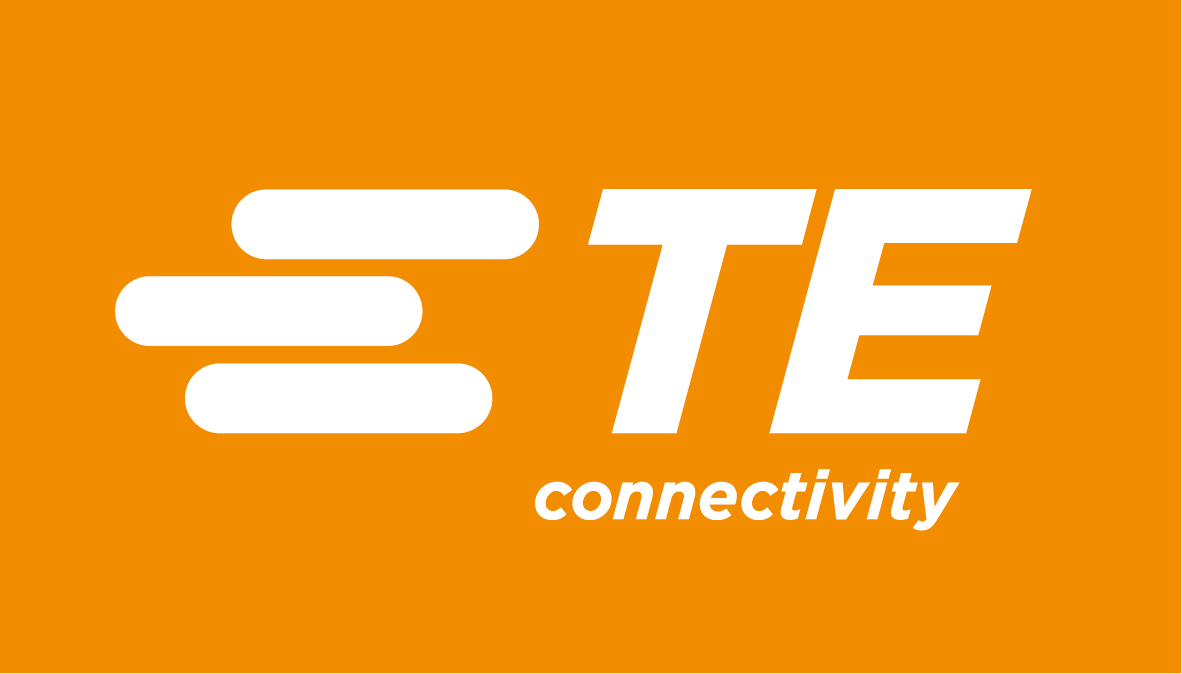
TE Connectivity
AI-based Real-time Molding Ejection Process Video Analysis
Molding processes use heat and pressure to fill a mold with certain materials. The mold can be opened and closed by controlling the two parts of a mold, Mold Base A and Base B. When the molding starts, the mold will be closed, and the materials will be injected. Once the injection is complete, the mold will be opened to eject the molding parts from the cavity. In this project, students will aim to monitor the ejection process through computer vision technologies. One objective this student team will work toward is to track the part ejection process to determine the optimal duration for opening the two bases, thus reducing the cycle time. The second objective is to develop a real-time monitoring functionality that can inform operators when parts are not ejected from cavity successfully. This student team will work to detect accuracy of parts during molding ejection and computational speed. This student team will work to i) train the model for detecting molding parts of different part numbers; ii) mold base opening cycle time optimization; iii) monitor part ejection failure. Several deliverables this student team will work to achieve are: i) an AI model that can detect molding parts of different part numbers in real-time (can be multiple models, to be determined) ii) corresponding training pipeline iii) a pipeline for molding ejection time optimization and related data analysis iv) a software that embeds the AI model and connects to the camera for real-time monitoring of part ejection to allow cycle time recording and alarm operators when ejection failure happens

TE Connectivity
Smart Manufacturing Lab in IEB – Design of AI-enhanced Cyber-physical Systems
The UW College of Engineering would like to set up a state-of-the-art digital twin space. One space will have machines, robotics, and physical space. The second lab will be the simulation/computer lab built for analyzing data. For this project, students will work on the physical lab space requirements. The student team will: 1) reach out to other top engineering universities to learn about the best designs of similar labs; 2) consult industrial software and hardware providers and end-users of digital twins & robotics (e.g. Boeing, Blue-Origin); 3) develop design options with cost estimations for College leadership; and 4) suggest courses in various department that can be enhanced with the labs, as well as course modules for summer camps for high school students. For this project, the student team will design the physical manufacturing space, taking into consideration the various use-cases from departments within the College of Engineering. They will work to identify square footage requirements, layout, and machinery. They will work together to identify metrics to read from the physical space that can be analyzed in the digital space. Students will need to interview representatives from each department to identify use-cases for the lab space. Students will also need to research other state-of-the-art institution lab spaces. The student team will provide: -Layout plans with square footage requirements -Resources required -Metrics that will be suitable across all disciplines within engineering and potential course offerings -Cost analytics

TE Connectivity
Smart Manufacturing Lab in IEB – Operations of AI-enhanced Cyber-physical Systems
The UW College of Engineering would like to set up a state-of-the-art digital twin space. One space will have machines, robotics, and physical space. The second lab will be the simulation/computer lab built for analyzing data. For this project, students will work on the simulation/computer lab space. The student team will: 1) reach out to other top engineering universities to learn about the best designs of similar labs; 2) consult industrial software and hardware providers and end-users of digital twins & robotics (e.g. Boeing, Blue-Origin); 3) develop design options with cost estimations for College leadership; and 4) suggest courses in various department that can be enhanced with the labs, as well as course modules for summer camps for high school students. For this project, the student team will work to analyze software, computing power, and resources needed to support the physical lab space. They will work to identify square footage requirements, layout, and hardware. They will work together to identify metrics to read from the physical space that can be analyzed in the digital space. Students will need to interview representatives from each department to identify use-cases for the lab space. Students will also need to research other state-of-the-art institution lab spaces. The student team will provide: -Layout plans with square footage requirements -Resources required -Metrics that will be suitable across all disciplines within engineering and potential course offerings -Cost analytics
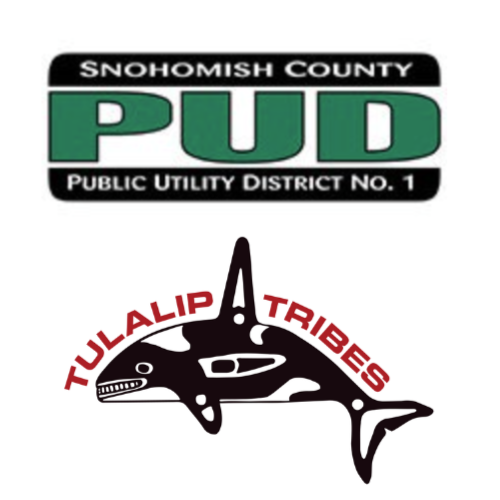
Tulalip Tribes and Snohomish Public Utility District
Resiliency for the Tulalip Tribes Government Center – Community Considerations
COMMUNITY DESCRIPTION: The Tulalip (pronounced Tuh’-lay-lup) Tribes are direct descendants of and the successors in interest to the Snohomish, Snoqualmie, Skykomish, and other allied bands signatory to the 1855 Treaty of Point Elliott. The treaty reserved the Tulalip Indian Reservation as a permanent homeland over which the Tulalip Tribes have retained inherent sovereign jurisdiction. The Tulalip Reservation exterior boundaries enclose a land-base of 22,000 acres rich with natural resources: marine waters, tidelands, freshwater creeks and lakes, wetlands, forests and developable land. The Tribe’s status as a sovereign entity maintains their right to self-govern as a “nation within a nation” and includes the inherent right as a government to raise revenue for the community. The reservation is governed by a board of seven directors chosen by Tribal members for three-year terms of service - a modern version of the separate Tribal Councils that governed the Tribes and allied bands for thousands of years in the Puget Sound. PROJECT DESCRIPTION: The partnership between the Tulalip Tribes and Snohomish County PUD allows two perspectives on how adding clean energy generation and storage across the Tribal Campus can support: (a) Tribal Goals for resiliency, cost savings, and carbon reduction, while also (b) enhancing SnoPUD’s capability to meet its growing electrical loads, while operating a stable and secure system. This project takes a community perspective on the plans to add significant new clean energy infrastructure, assessing the reduction in energy costs to the community, added resiliency to outages, and the lowering of carbon emissions. Ultimately the technical and economic analysis will support community discussions of options and grant getting. The timeline and deliverables are expected to include the following: • December/January: Review any prior reports on individual building performance, preliminary design or data analysis for distributed energy resources on the main Tribal Campus, meter and billing data. Assign building load synthesis projects across both Tulalip/SnoPUD groups. • Winter Quarter, 2025: Students will create simulated 1-hour load profiles that represent major Tribal Campus buildings based on actual billing data, national building performance data, assessment of building use cases, and other information gleaned from a site visit. Winter Deliverables: Simulated 1 hour data for a “Business as Usual” (BAU) year, and Statement of Work (SOW) for Spring. • Spring Quarter, 2025: Design and analysis addressing tasks in SOW will identify buildings with greatest potential for reducing BAU bills and meet community resiliency goals during extended outages through distributed clean energy resources. Critical loads during outages will be estimated and prioritized based on community input and goals, and resilience introduced by solar + storage and other back-up generation will be assessed for high priority buildings. Final Reports and a Showcase presentation will be completed in late May or early June. • Optional K-12 Classroom and/or Adult Education Programs. Separate from this project, the Clean Energy Institute has an active grades 4th-12th “Ambassador” program that introduces clean energy ideas to young people as a way to advance community conversations and support next-generation science in schools. We also recently established a new adult-oriented clean energy education program that was piloted at a senior center. If of interest to the community, we would be happy to discuss Clean Energy community education programs with you.

Tulalip Tribes and Snohomish Public Utility District
Resiliency for the Tulalip Tribes Government Center – Utility Considerations
COMMUNITY DESCRIPTION: The Tulalip (pronounced Tuh’-lay-lup) Tribes are direct descendants of and the successors in interest to the Snohomish, Snoqualmie, Skykomish, and other allied bands signatory to the 1855 Treaty of Point Elliott. The treaty reserved the Tulalip Indian Reservation as a permanent homeland over which the Tulalip Tribes have retained inherent sovereign jurisdiction. The Tulalip Reservation exterior boundaries enclose a land-base of 22,000 acres rich with natural resources: marine waters, tidelands, freshwater creeks and lakes, wetlands, forests and developable land. The Tribe’s status as a sovereign entity maintains their right to self-govern as a “nation within a nation” and includes the inherent right as a government to raise revenue for the community. The reservation is governed by a board of seven directors chosen by Tribal members for three-year terms of service - a modern version of the separate Tribal Councils that governed the Tribes and allied bands for thousands of years in the Puget Sound. PROJECT DESCRIPTION: The partnership between the Tulalip Tribes and Snohomish County PUD allows two perspectives on how adding clean energy generation and storage across the Tribal Campus can support: (a) Tribal Goals for resiliency, cost savings, and carbon reduction, while also (b) providing new dispatchable utility capacity that helps SnoPUD meet its growing electrical loads, while operating a stable and secure system. This project takes a utility perspective on the Tulalip plans to add significant new clean energy infrastructure and assesses some of its benefits and consequences to the utility operations. The timeline and deliverables are expected to include the following: • December/January: Review any reports on prior preliminary design or data analysis, organize the PUD substation, meter and billing data. Assign building load synthesis projects across both Tulalip/SnoPUD groups. • Winter Quarter, 2025: Students will create simulated 1-hour load profiles that represent major Tribal Campus buildings based on billing data, national building performance data, assessment of building use cases, and other information gleaned from a site visit. Winter Deliverables: Simulated 1 hour data for a “Business as Usual” (BAU) year, and Statement of Work (SOW) for Spring. • Spring Quarter, 2025: Design and analysis addressing tasks in SOW will include power flow analysis in the BAU Case and various clean energy installation scenarios. The utility-oriented economic analysis will estimate utility costs and savings associated with using tribal resources vs. BPA and other peak power providers, as well as potential savings from deferred infrastructure investments. Final Reports and a Showcase presentation will be completed in late May or early June. • Optional K-12 Classroom and/or Adult Education Programs. Separate from this project, the Clean Energy Institute has an active grades 4th-12th “Ambassador” program that introduces clean energy ideas to young people as a way to advance community conversations and support next-generation science in schools. We also recently established a new adult-oriented clean energy education program that was piloted at a senior center. If of interest to the community, we would be happy to discuss Clean Energy community education programs with you.
Related News
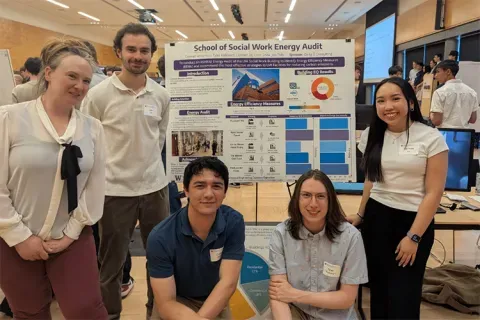
Mon, 10/13/2025 | UW Mechanical Engineering
Capstone collaboration leads to award
An ME capstone team received first place for its energy audit of the UW School of Social Work building.
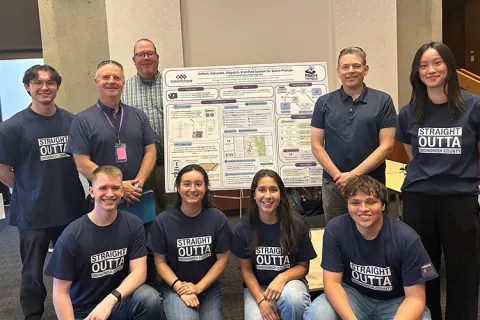
Thu, 07/17/2025
UW engineering students develop smart ballot solution
UW engineering students develop smart technology solution to improve ballot collection for Snohomish County.
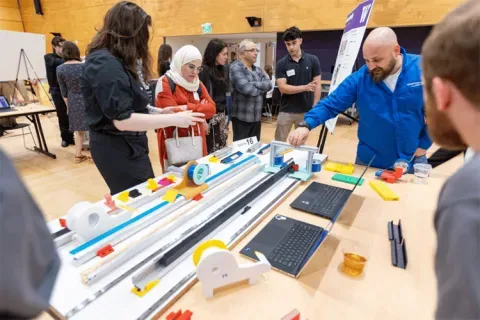
Mon, 07/07/2025 | UW Mechanical Engineering
Capstone creations
Students displayed innovative capstone design projects at the 2025 expo.
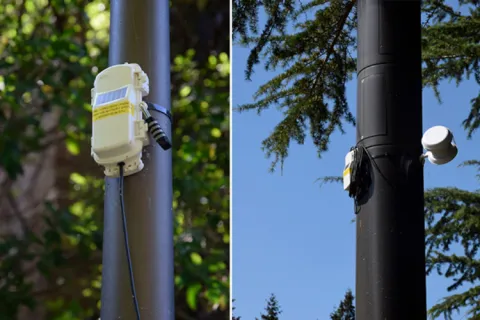
Fri, 09/20/2024 | UW Civil & Environmental Engineering
Smarter irrigation for a greener UW
A new project combines satellite data with ground sensors to conserve water and create a more sustainable campus environment.